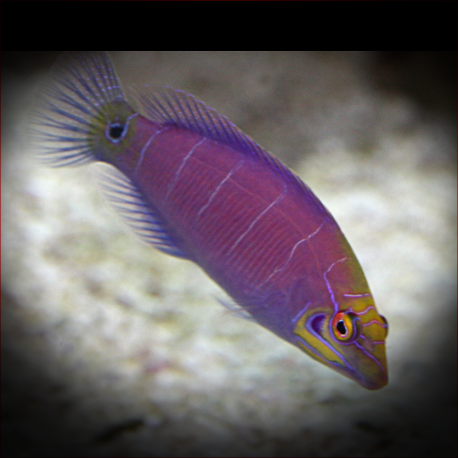More info
Datasheet
| Minimum Tank Size | 200 litres / 52.83 US gallons |
| Maximum Size | 9.0cm / 3.54inches |
| Reef Compatible | Always reef safe |
| Temperament | Might be aggressive towards other species |
| Temperature | 22.2°C / 71.96°F - 25.6°C / 78.08°F |
| Specific Gravity | 1.020-1.025 |
| Carbonate Hardness | 8-12 |
| pH | 8.1-8.4 |
General Description
The Whitebarred wrasse, scientifically known as Pseudocheilinus ocellatus, belongs to the Labridae family. These fish are popular in aquariums due to their attractive appearance and effectiveness in controlling flatworms and pyramid snails. They typically do not burrow into the sand but prefer sleeping between rocks. This species, found mainly in the Western Central Pacific, is a small fish, reaching a maximum size of 9.0cm.
Aquarium Suitability
The Whitebarred wrasse is considered suitable for most aquariums with a minimum tank size of 200 liters. However, due to their aggressive nature, they can be a threat to smaller fish and crustaceans in the tank, necessitating careful consideration when selecting tankmates. Additionally, this species is known for jumping out of open aquaria, so a secure lid is recommended.
Demands, Care and Hardiness
With average hardiness, these wrasses require stable water conditions with a pH of 8.1-8.4, a temperature range of 22.2-25.6°C, and a specific gravity of 1.020-1.025. They feed on a variety of foods, including small crustaceans, zooplankton, and commercial flakes and frozen foods, ensuring they are well-fed several times a day. Providing hiding spots among rocks is essential for their well-being in the aquarium.
Reef Suitability
The Whitebarred wrasse is known to be reef-safe, making them a good addition to reef aquariums. They can help control unwanted invertebrates like flatworms and pyramid snails, contributing positively to the reef ecosystem.
Aquarium Setup
It is crucial to provide ample hiding spaces for the Whitebarred wrasse, such as live rocks and crevices. Additionally, a secure lid should be in place to prevent them from jumping out of the tank. Tankmates should be chosen carefully to avoid potential aggression from this species.
Behaviour
These wrasses can exhibit aggressive behavior towards fish of similar size if not given enough space in the aquarium. They may initially be shy when introduced to a new environment but can become more active as they acclimatize. It is recommended to introduce less aggressive fish after the Whitebarred wrasse has settled in.
Feeding and Diet
Their diet consists of small crustaceans like krill and mysis, as well as zooplankton such as Cyclops and pods. While they are known to feed on flatworms and pyramid snails, individual preferences may vary, requiring observation to ensure adequate nutrition.
Dimorphism
The Whitebarred wrasse can change gender from female to male, with females transitioning when a male is needed in the group. This reproductive phenomenon contributes to the unique life cycle of this species.
Habitat and Distribution
Found in regions like Australia, Japan, Indonesia, and the East Pacific, the Whitebarred wrasse thrives in the Central/Western Pacific. They prefer rocky habitats with hiding spots, reflecting their behavior of seeking shelter among rocks rather than burrowing in sand.

